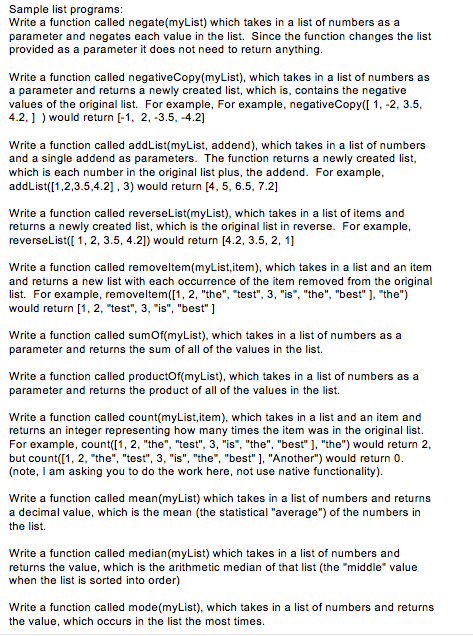
Sample list programs Write a function called negate(myList) which takes in a list of numbers as a parameter and negates each value in the list. Since the function changes the list provided as a parameter it does not need to return anything Write a function called negativeCopy(myList), which takes in a list of numbers as a parameter and returns a newly created list, which is, contains the negative values of the original list. For example, For example, negativeCopy(1 -2, 3.5 4.2,] ) would return [-1, 2, -3.5, -4.2] Write a function called addList(myList, addend), which takes in a list of numbers and a single addend as parameters. The function returns a newly created list, which is each number in the original list plus, the addend. For example addList([1,2,3.5,4.2], 3) would return [4, 5, 6.5, 7.2] Write a function called reverseList(myList), which takes in a list of items and returns a newly created list, which is the original list in reverse. For example reverseList( 1, 2, 3.5, 4.2]) would return [4.2, 3.5, 2, 1] Write a function called removeltem(myList,item), which takes in a list and an item and returns a new list with each occurrence of the item removed from the original list. For example, removeltem(1, 2, "the", "test", 3, "is", "the", "best" ], "the") would return [1, 2, "test", 3, "is", "best"] Write a function called sumOf (myList), which takes in a list of numbers as a parameter and returns the sum of all of the values in the list. Write a function called productOf(myList), which takes in a list of numbers as a parameter and returns the product of all of the values in the list. Write a function called count(myList,item), which takes in a list and an item and returns an integer representing how many times the item was in the original list. For example, count(l1, 2, "the", "test", 3, "is", "the", "best" ], "the") would return 2 but count([1, 2, "the", "test", 3, "is", "the", "best" ], "Another") would return 0 (note, I am asking you to do the work here, not use native functionality) Write a function called mean(myList) which takes in a list of numbers and returns a decimal value, which is the mean (the statistical "average") of the numbers in the list. Write a function called median(myList) which takes in a list of numbers and returns the value, which is the arithmetic median of that list (the "middle" value when the list is sorted into order) Write a function called mode(myList), which takes in a list of numbers and returns the value, which occurs in the list the most times







